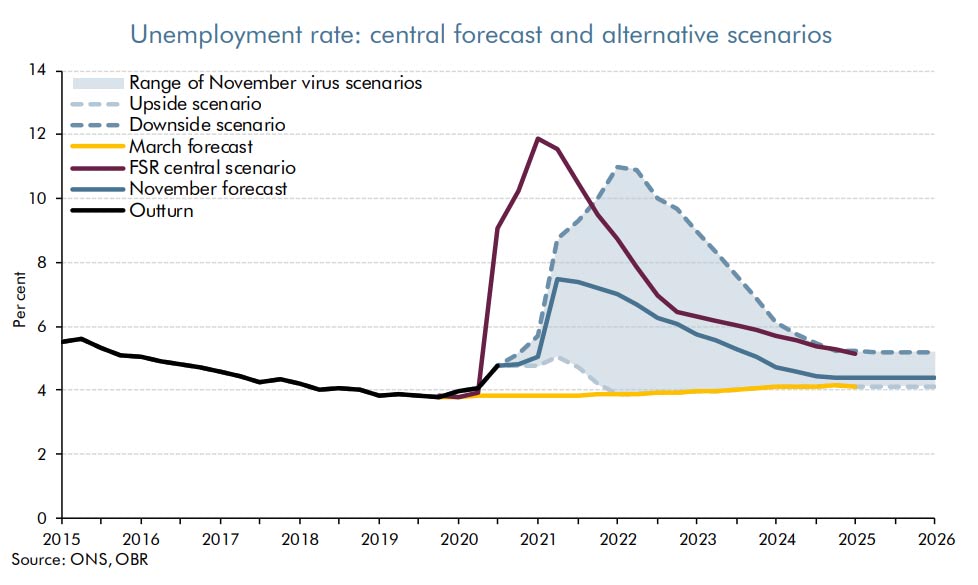Unemployment in 2021 is anticipated to rise to 4 million

UK labour market: November 2020 – more measures needed to support jobs recovery as weak labour market figures driven by continued fall in hiring and spare capacity
Sector response to November ONS Labour Market Stats Release:
 Tony Wilson, Director of the Institute for Employment Studies:
Tony Wilson, Director of the Institute for Employment Studies:
“Today’s figures show that the labour market continued to weaken through the autumn, weighed down by the ongoing fallout from the first lockdown. Firms have brought back around four million people from furlough, but made redundant just over 300 thousand. Redundancies are now higher than they were at the peak of the last recession, and rising at their fastest ever rate. We anticipate that they will peak at around 450 thousand a quarter by the end of the year.
“Of most concern today however are new figures showing that hiring continued to fall through the summer, and was lower even than it was during lockdown itself – with 1.4 million people starting a new job, compared with 1.5 million during lockdown (and 1.7 million before the crisis). This will reflect both the huge spare capacity in firms as they dealt with furlough and the crisis, but also continued uncertainty about the future including as a result of Brexit. This in turn is feeding through into particularly acute impacts on youth employment, which is down by more than a quarter of a million to its lowest ever level. In all, more than half of the total fall in employment is explained by fewer young people in work.
“Looking ahead, the second lockdown means that these figures are likely to deteriorate further through the winter, and this will be added to by uncertainty around Brexit. With the Spending Review just a few weeks away, the Chancellor needs to look at measures to get hiring going again and quickly – in particular by raising the National Insurance threshold so as to reduce labour taxes for firms, and by boosting departmental budgets so that public sector employment can pick up more of the slack from the private sector.”
 Samantha Windett, Director of Policy at Impetus and Chair of the Youth Employment Group said:
Samantha Windett, Director of Policy at Impetus and Chair of the Youth Employment Group said:
“As the UK unemployment rate continues to surge, it’s clear that young people are being worst hit. Often hit by the last in first out policy, the number of 16 to 24-year-olds in employment dropped 174,000 over the last quarter to a record low of 3.52 million – nearly three times the decrease as for the whole 35-64 age bracket.
“It’s clear we need a huge cross-government effort to tackle this problem, starting with this month’s Spending Review where significant amounts of funding must be allocated to driving positive outcomes for young people.
“This uncertainty is set to continue for young people as we navigate COVID-19 restrictions through the winter period as they are more likely to work in the shutdown sectors, like hospitality and retail. We estimate that over 1000 extra employment, training or education opportunities are needed every day to bring the number of young people not in education employment or training back to pre-crisis levels by Autumn next year. It’s crucial we do everything we can to ensure more young people avoid the scarring effects of long-term unemployment – we can’t let this generation down.”
 Dave Innes, Head of Economics at the Joseph Rowntree Foundation, said:
Dave Innes, Head of Economics at the Joseph Rowntree Foundation, said:
“With unemployment already rising sharply and a record number of redundancies in September – even before the second wave hit – today’s figures point to a tough winter ahead for many. For families already in poverty it will be tougher still.
“In the face of continued uncertainty the Government was right to extend the furlough scheme until March 2021. But the eleventh-hour decision will have cost jobs and will give little comfort to those who have already been made redundant. The poorest are being hit hardest too: low-paid workers are more likely to work in sectors where jobs are most at risk.
“With each job lost, the case for making the £20 a week increase to Universal Credit permanent only becomes stronger. The Government must also extend this lifeline to those on legacy benefits, and take the decision as soon as possible. In the midst of the deepest recession on record it just isn’t right to leave 16 million people waiting to know if they will be £1000 worse off a year from April.”
 Chancellor of the Exchequer, Rishi Sunak, said:
Chancellor of the Exchequer, Rishi Sunak, said:
“Today’s figures underline the scale of the challenge we’re facing. I know that this is a tough time for those who have sadly already lost their jobs, and I want to reassure anyone that is worried about the coming winter months that we will continue to support those affected and protect the lives and livelihoods of people across this country.
“That’s why we’ve extended the furlough scheme until March to protect millions of jobs across the UK and support people to continue to provide for their families.
“And for young people, who have been particularly hit by this crisis, we’ve launched the £2 billion Kickstart Scheme to create hundreds of thousands of new, fully subsidised jobs to ensure nobody is left without hope or opportunity.”
 Kirstie Donnelly MBE, CEO of City & Guilds Group commented:
Kirstie Donnelly MBE, CEO of City & Guilds Group commented:
“The latest unemployment data paints a truly worrying picture for the long-term health of the UK jobs market. With unemployment surging to 4.8%, is it now time to accept that the Government’s attempts to redirect and retrain the newly unemployed does not go far enough. We urge Government to prioritise working with local authorities and business leaders to create long-term solutions to curtail the looming jobs crisis and make employment pathways more accessible.
“This is not about reinventing the wheel, but rather developing grassroots solutions to match skills to jobs, and supply to demand – and we propose that a national network of Employment and Training Hubs could help join the dots. As we move deeper into the second lockdown and see its impact, providing people with the right support and framework to gain the necessary skills, advice and access to meaningful employment, is more crucial than ever.”
 Stephen Evans, chief executive of Learning and Work Institute, said:
Stephen Evans, chief executive of Learning and Work Institute, said:
“Today’s data reflect the partial reopening of the economy during the summer. Total hours worked and vacancies rose, while the rise in unemployment was partly driven by more people starting to look for work though employment did fall too. Nonetheless, employment, hours worked and vacancies remain below pre-pandemic levels.
“We face a long winter of tighter restrictions ahead. The extension of the furlough scheme will help to cushion the blow, but a record rise in redundancies shows we have tough times ahead. With tentatively positive signs for a vaccine, the case for continuing economic support to limit the damage is clear.”
 James Reed, Chairman of REED, said:
James Reed, Chairman of REED, said:
“It’s no real surprise that today’s ONS figures show a gloomy picture of the UK’s labour market as the pandemic continues to make an impact. Given the latest lockdown restrictions, it’s clear support from the government was needed to stave off mass redundancies – the extension of the furlough scheme to March is welcome and will help companies and individuals manage this transition.
“There are bright spots breaking through, and signs that the UK economy is turning a corner towards job growth. Reed.co.uk saw over 162,000 new jobs posted in October – a 15% increase on September.
“The strong GDP resurgence reported in Q3 translated into jobs over Autumn and the second lockdown hasn’t yet had the same negative effect as the first. On the REED website last week, we saw the second-highest number of new jobs posted since the pandemic began in March, aided by a rise in seasonal job vacancies.
“The jobs market over the past nine months has gone through a storm of biblical proportions, but the outlook for the new year is sunny. I expect a rapid recovery in the labour market in 2021 driven by improved testing, improved treatment and potentially a new vaccine which would make future lockdowns unnecessary.”
 Neil Carberry, Chief Executive of the Recruitment and Employment Confederation said:
Neil Carberry, Chief Executive of the Recruitment and Employment Confederation said:
“There are few surprises in today’s data, and we know that tackling rising unemployment will be a national priority over the next few months. But news in the past week – of progress on a vaccine and in the extension of support packages – should mean businesses have more confidence to retain people and bring on new staff than they had a couple of weeks ago.
“Nevertheless, we are in a tough spot with redundancies hitting a record a record 314,000 in the three months to September. The focus needs to be on measures that will help employers retain staff and create new jobs, starting with a sensible approach to tax. Reducing employers National Insurance contributions, the biggest tax on business, will help struggling businesses retain jobs while encouraging those which need extra capacity to hire more staff.
“We now have 50 days until the Brexit transition period ends. The restarting of negotiations is promising but every effort must be made now to secure a deal that ensures businesses can continue to trade, especially in services which makes up 80% of our economy.”
Recruitment expert Paul Naha-Biswas, CEO and Founder at recruitment tech platform Sixley:
“The ONS’s latest UK labour market figures show the bruising economic impact of the pandemic – and the figures don’t tell the complete picture either. UK businesses and the workforce are facing challenging economic times, exacerbated by the restrictions imposed following the second lockdown.
“However, there are some positive signs that the UK economy bounced back from the first lockdown with significant growth in Q3 and there’s hope it can do so again in December, especially with further government support thanks to the extension of the furlough scheme.
“Regardless, jobseekers are on the rise among those furloughed and unemployed, and even those in employment who are looking for new pastures in 2021. After a period of stagnation, the labour market is being mobilised again and we must be ready to approach recruitment in different ways when restrictions ease and businesses reopen. We should take collective responsibility by looking out for job opportunities and sharing them with our network. Recommending contacts for roles can help them stand out in a crowded space and can reduce the investment of time and money for businesses.
“Never before has the pool of talent available to businesses been so strong and diverse, and those businesses who show the most dynamism in recruitment will benefit the most in the short and long term.”
Richard Churchill a business advisory partner at Blick Rothenberg said:
“The latest unemployment figures issued by the Office of National Statistics shows that unemployment is going up with 4.8% percent of the country unemployed but in 16 to 24-year olds that rises to 14.6%”
“More needs to be in terms of job creation to assist the young who are this country’s future.
“The increase in unemployment and spike in redundancies was expected but it is gravely worrying to see the impact on the youngest age bracket. A sharp increase in redundancies in that age group means they are 50% more likely to be made redundant than the overall redundancy rate.
“It is the young that suffer when businesses have to make short term decisions to reduce headcount, with the least cost option chosen, as opposed to plan for the longer-term success of their business.
“Much more needs to be done to assist job creation and in particular job creation for the young. Whilst training and apprenticeship schemes have been announced these are not accessible to all industries and often feel complicate for small businesses. Direct grants or Employers NI holidays to support businesses employing those in the 16-24 age range would be easily understood and encourage surviving businesses to recruit.
“The data reported by Office for National Statistics shows a rise in unemployment at the end of September with a spike in redundancies reflects the uncertainty caused by the anticipated end of the Job Retention Scheme in October.
“Originally a lack of planned support from Government after 31 October, meant Businesses had started to reduce their workforce as they sought to reduce costs. It is clear the Job Retention Scheme delayed redundancies as opposed to preventing them. The level of government support for furlough reduced during this period meaning that employers had to pay 1/8 of the furlough wage in September. This went to ¼ in October. Many businesses simply were unable to absorb this cost for non-active employees.
“The results for next month covering the period to 31 October are likely to follow the same trend with a likely record level of redundancies as sadly the Governments 11th hour reprieve of the Job Retention Scheme will have come too late for many businesses.
“Additionally those are made redundant who wish to start their own business need help and advice to do so. The Business Secretary should create a national knowledge sharing forum encouraging input from businesses leaders and professionals to support the unemployed who wish to start their own business.”
Ruth Gregory, UK Economist at Capital Economics says the extension of the scheme by Sunak will probably only delay inevitable job losses:
“Once removed in April, employment will probably fall back in line with GDP, suggesting that employment will fall by a total 6.0%, or 2 million and the unemployment rate will rise from 4.8% in September to a peak of 9% next year,”
Further information from Treasury:
Our unprecedented package of grants, loans and employment support worth over £210bn has protected millions of jobs and businesses across the country.
Our Plan for Jobs supports, creates and protects jobs and includes measures to provide opportunities and skills to those who’ve lost their jobs, including through:
- Our £2bn Kickstart scheme which will create hundreds of thousands of new, fully subsidised jobs for young people looking for new opportunities.
- A £111 million investment to triple the scale of traineeships in 2020-21 ensuring more young people have access to high quality training.
- £17 million of funding to triple the number of sector-based work academy placements in 2020-21
- Nearly £900 million to double the number of work coaches to 27,000
- Over a quarter of a million more young people to benefit from an extra £32 million investment in the National Careers Service
Estimates of employment, unemployment, economic inactivity and other employment-related statistics for the UK.
Documents
UK labour market: November 2020
Regional, local authority and Parliamentary constituency breakdowns of changes in UK employment, unemployment, economic inactivity and other related statistics.
Earnings and employment from Pay As You Earn Real Time Information, UK: November 2020
Experimental monthly estimates of paid employees and their pay from HM Revenue and Customs’ (HMRC) Pay As You Earn (PAYE) Real Time Information (RTI) data, including a flash estimate of employment and median pay for the most recent month. This is a joint release between HMRC and the Office for National Statistics (ONS).
Labour market in the regions of the UK: November 2020
Official statistics are produced impartially and free from political influence.












Responses